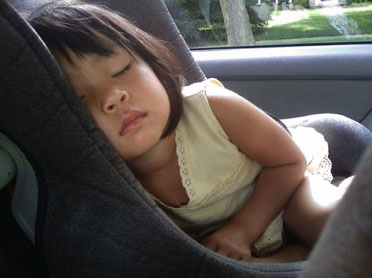In 2015, 84 children died on German roads. In the tables of the Federal Statistical Office, this is a low number compared to previous years. In 1978, almost 1,450 adolescents still died on the roads. The development is positive – at least when viewed only on the basis of the statistics. But behind every underage road fatality there is also a personal tale of woe – especially that of the parents and siblings. There are many reasons for the significant drop in the number of accidents and the number of injured and killed children. Increasingly improved safety technology in motor vehicles is part of this.

The child seat also makes its contribution. Small children like to find it annoying, but it has now become an important safety element that protects the offspring. Because the safety devices in the car – such as the seat belt or front and side airbags – often only take effect when the passengers are a certain size. In order for the child seat to meet the requirements placed on it, various properties must be right. And of course the selection has become so large in recent years that many parents are quickly overwhelmed – and are unsettled by the different categories and designs. What should the right child seat look like?
The fines according to the StVO
The safety of children on the road is of particular interest to society. The legislature cannot regulate all aspects – such as in the form of a helmet requirement on the impeller. However, as soon as parents take their children with them in the car, legal requirements come into effect, which are intended to ensure a high level of safety.
The road traffic regulations – StVO for short – are decisive for this. With Section 21 StVO, the legislator stipulates in detail the age up to which children can be taken with them in a child seat. Age and height are important here.
If the offspring has not yet reached the height of 1.50 meters, they are only allowed to be taken in so-called restraint systems. This applies until the child has not yet reached the age of 12. Children above this age/height limit may only be secured on the seats with safety goods.
By the way: If parents are caught by the police during a traffic check with children in the vehicle that are not properly secured, a fine and possibly even points in the traffic offender file will be due. A distinction is made between:
- not secured according to regulations (with belt, but no child seat) – 30 euros
- no backup – 60 euros
The latter violation also entails a point in Flensburg. If the violation affects several children, the fine can be even higher. How exactly do restraint devices have to be designed so that parents behave in accordance with the rules on the road?
What should a good child seat bring?
How do parents recognize a good child seat? There really isn’t a general answer to this question. Background: Not only the seat is decisive, but also the type of vehicle and the personal preferences of the child.

Experts – such as from the DVR – see an adequate solution in terms of safety in the child seats with impact shields. However, not every child agrees with the impact shield, which fixes the upper body. Belt systems are better accepted by some children.
From the point of view of the parents, test criteria for a child seat should include the following aspects:
- security
- ergonomics
- service
- pollution
- cleaning
Of course, the first two aspects are particularly important here. Security is the essential element. The following factors contribute to this, for example:
- the seat in the car
- side impact protection
- the risk of injury in a frontal crash
Appropriate child seats are offered at vertbaudet.de, for example. Many of the seats presented there have been subjected to appropriate tests.
Important: It must be easy for the parents to operate the restraint system, but it should prevent the offspring from being able to loosen the belt system or the impact shield themselves.
In terms of ergonomics, the seating position and upholstery play a role. At this point, the issue is that the offspring can make themselves comfortable in the child seat even on longer car journeys and still be safe on the road.
Infant carrier to booster seat: The various safety solutions:
The decision to buy a child seat is influenced by the weight and size of the child. The problem: Today there are several standards, which does not really make it easier for parents to choose the restraint system.
For years, parents have been guided by the ECE-R 44 standard, the classification of which is essentially based on weight. The four classes cover the spectrum between less than 13 kilograms and 36 kilograms.
ECE-R 44 classes at a glance:
- Class 0+ – under 13 kilograms
- Class I – 9 to 18 kilograms
- Class II – 15 to 25 kilograms
- Class III – 22 to 36 kilograms
Commercially available seats can include two or three classes. The increasingly widespread ECE-R 129 standard is aimed at the height of the child and includes a total of six classes. Class Q0 is under 60 centimetres, while Class Q10 is for older children over 125 centimetres.
Tip: Child seats for infants/toddlers up to 15 months are installed rearward facing and are generally referred to as infant carriers. Only with the change to class I may the restraint devices be installed forward-facing.
For larger children from around 15 kilograms, parents can use a booster seat according to ECE-R 44. However, the side impact protection is significantly reduced here. This is where alternatives come in handy – such as the booster seat with a back section.
Conclusion: always buckle children securely in the car
Fortunately, the number of children killed in road traffic accidents has continued to decline in recent years. This is also a merit of the child seats. The latter are prescribed by the Road Traffic Act. Parents who do not do this risk a fine, points – and the safety of their own children. But it is not enough to simply buy any child seat. In the interests of safety, it must be a matter of choosing the right model. The previously applicable standard ECE-R 44 is increasingly being replaced by ECE/UN regulation no. 129 (iSize). Of course, the purchase decision does not make this development any easier. It is best for parents to simply let their offspring sit for a test – and then make the decision for or against a child seat.
